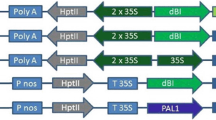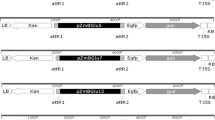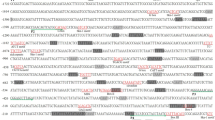Abstract
A prerequisite for biotechnological improvements of storage roots is the availability of tissue-specific promoters enabling high expression of transgenes. In this work, we cloned two genomic fragments, pMe1 and pDJ3S, controlling the expression of a gene with unknown function from cassava (Manihot esculenta) and of the storage protein dioscorin 3 small subunit gene from yam (Dioscorea japonica), respectively. Using β-glucuronidase as a reporter, the activities of pMe1 and pDJ3S were evaluated in independent transgenic carrot lines and compared to the constitutive CaMV35S and the previously described cassava p15 promoters. Activities of pMe1 and pDJ3S in storage roots were assessed using quantitative GUS assays that showed pDJ3S as the most active one. To determine organ specificities, uidA transcript levels in leaves, stems and roots were measured by real-time RT-PCR analyses showing highest storage root specificity for pDJ3S. Root cross sections revealed that pMe1 was highly active in secondary xylem. In contrast, pDJ3S was active in all root tissues except for the central xylem. The expression patterns caused by the cassava p15 promoter in carrot storage roots were consistent with its previously described activities for the original storage organ. Our data demonstrate that the pDJ3S and, to a lesser extent, the pMe1 regulatory sequences represent feasible candidates to drive high and preferential expression of genes in carrot storage roots.




Similar content being viewed by others
Abbreviations
- CaMV:
-
Cauliflower mosaic virus
- DJ :
-
Dioscorea japonica
- GUS:
-
β-Glucuronidase
- Me :
-
Manihot esculenta
- uidA :
-
β-Glucuronidase gene
References
Al-Babili S, Hoa T, Schaub P (2006) Exploring the potential of the bacterial carotene desaturase CrtI to increase the beta-carotene content in Golden Rice. J Exp Bot 57:1007–1014
Ariza-Nieto M, Sanchez T, Heller L, I Hu Y, Welch M, Glahn P et al (2006) Cassava (Manihot esculenta) has high potential for iron biofortification. FASEB J 20:A624
Bahieldin A, Eissa F, Mahfouz H, Dyer E, Madkour A, Qu R et al (2005) Evidence for non-proteinaceous inhibitor(s) of b-glucuronidase in wheat (Triticum aestivum L.) leaf and root tissues. Plant Cell Tiss Org 82:11–17
Booth R (1976) Storage of fresh cassava (Manihot esculenta) I. Post-harvest deterioration and its control. Exp Agric 12:103–111
Ceballos H, Iglesias A, Pérez C, Dixon G (2004) Cassava breeding: opportunities and challenges. Plant Mol Biol 56:503–516
Chávez L, Ceballos H, Rodriguez-Amaya D, Nestel P, Ishitani M (2006) Reduction or delay of post-harvest physiological deterioration in cassava roots with higher carotenoid content. Sci Food Agric 86:634–639
Diretto G, Al-Babili S, Tavazza R, Papacchioli V, Beyer P, Giuliano G et al (2007) Metabolic engineering of potato carotenoid content through tuber-specific overexpression of a bacterial mini-pathway. PloS ONE 2:e350
Elliott MC, Weston GD (1993) Biology and physiology of the sugar-beet plant. In: Cooke DA, Scott RK (eds) The sugar beet crop: science into practice. Chapman and Hall, London, pp 37–66
FAO (2000) Production yearbook 1999. FAO statistics series No. 53. FAO, Rome
Fray G, Wallace A, Fraser D, Valero D, Hedden P, Bramley M et al (1995) Constitutive expression of a fruit phytoene synthase gene in transgenic tomatoes causes dwarfism by redirecting metabolites from the gibberellin pathway. Plant J 8:693–701
Gaidamashvili M, Ohizumi Y, Iijima S, Takayama T, Ogawa T, Muramoto K (2004) Characterization of the yam tuber storage proteins from Dioscorea batatas exhibiting unique lectin activities. J Biol Chem 279:26028–26035
González E, Schöpke C, Taylor J, Beachy N, Fauquet C (1998) Regeneration of transgenic cassava plants (Manihot esculenta Crantz) through Agrobacterium-mediated transformation of embryogenic suspension cultures. Plant Cell Rep 17:827–831
Hardegger M, Sturm A (1998) Transformation and regeneration of carrot (Daucus carota L.). Mol Breed 4:119–127
Higo K, Ugawa Y, Iwamoto M, Korenaga T (1999) Plant cis-acting regulatory DNA elements (PLACE) database: 1999. Nucleic Acids Res 27:297–300
Ihemere U, Arias-Garzon D, Lawrence S, Sayre R (2006) Genetic modification of cassava for enhanced starch production. Plant Biotechnol 4:453–465
Jefferson RA (1987) Assaying chimeric genes in plants: the GUS gene fusion system. Plant Mol Biol Rep 5:387–405
Jefferson RA, Kavanagh RA, Bevan MW (1987) GUS-fusions: β-glucuronidase as a sensitive and versatile fusion marker in higher plants. EMBO J 6:3901–3907
Jørgensen K, Bak S, Busk K, Sørensen C, Olsen E, Puonti-Kaerlas J et al (2005) Cassava plants with a depleted cyanogenic glucoside content in leaves and tubers. Distribution of cyanogenic glucosides, their site of synthesis and transport, and blockage of the biosynthesis by RNA interference technology. Plant Physiol 139:363–374
Lindgren O, Stålberg G, Höglund A (2003) Seed-specific overexpression of an endogenous Arabidopsis phytoene synthase gene results in delayed germination and increased levels of carotenoids, chlorophyll, and abscisic acid. Plant Physiol 132:779–785
Livak KJ (1997) User bulletin No. 2: ABI PRISM 7700 sequence detection system. PE Applied Biosystems Foster City, CA, pp 11–15
Lopez C, Jorge V, Piégu B, Mba C, Cortes D, Restrepo S et al (2004) A unigene catalogue of 5700 expressed genes in cassava. Plant Mol Biol 56:41–54
Lowe S, Mahon J, Hunt L (1982) Early development of cassava (Manihot esculenta). Can J Bot 60:3040–3048
Maass D, Arango J, Wüst F, Beyer P, Welsch R (2009) Carotenoid crystal formation in Arabidopsis and carrot roots caused by increased phytoene synthase protein levels. PloS ONE 4:e6373
Marchler-Bauer A, Anderson B, Chitsaz F, Derbyshire K, DeWeese-Scott C, Fong H et al (2009) CDD: specific functional annotation with the conserved domain database. Nucleic Acids Res 37:D205–D210
Montagnac A, Davis R, Tanumihardjo A (2009) Nutritional value of cassava for use as a staple food and recent advances for improvement. Comp Rev Food Sci Saf 8:181–194
Nweke F, Spencer D, Lynam J (2002) The cassava transformation: Africa’s best-kept secret. Michigan State University Press, East Lansing, USA
Paine A, Shipton A, Chaggar S, Howells M, Kennedy J, Vernon G et al (2005) Improving the nutritional value of Golden Rice through increased pro-vitamin A content. Nat Biotechnol 23:482–487
Sambrook J, Russell W (2001) Molecular cloning: a laboratory manual. Cold Spring Harbor Laboratory Press, Cold Spring Harbor, NY
Shewmaker C, Sheehy J, Daley M, Colburn S, Ke D (1999) Seed-specific overexpression of phytoene synthase: increase in carotenoids and other metabolic effects. Plant J 20:401–412
Shewry R (2003) Tuber storage proteins. Ann Bot 91:755–769
Surles L, Weng N, Simon W, Tanumihardjo A (2004) Carotenoid profiles and consumer sensory evaluation of specialty carrots (Daucus carotaL.) of various colors. J Agric Food Chem 52:3417–3421
Verdaguer B, Kochko A, Beachy N, Fauquet C (1996) Isolation and expression in transgenic tobacco and rice plants, of the cassava vein mosaic virus (CVMV) promoter. Plant Mol Biol 31:1129–1139
Ye X, Al-Babili S, Klöti A, Zhang J, Lucca P, Beyer P et al (2000) Engineering the provitamin A (β-Carotene) biosynthetic pathway into (carotenoid-free) rice endosperm. Science 287:303–305
Zhang P, Potrykus I, Puonti-Kaerlas J (2000) Efficient production of transgenic cassava using negative and positive selection. Transgenic Res 9:405–415
Zhang P, Bohl-Zenger S, Puonti-Kaerlas J, Potrykus I, Gruissem W (2003) Two cassava promoters related to vascular expression and storage root formation. Planta 218:192–203
Acknowledgments
This work was funded by The HarvestPlus research consortium (http://www.harvestplus.org) and by the Deutsche Forschungsgemeinschaft (DFG), Graduiertenkolleg 1305 “Signalsysteme in pflanzlichen Modellorganismen”. We are indebted to Paul Chavarriaga for valuable discussions.
Author information
Authors and Affiliations
Corresponding author
Additional information
Communicated by R. Reski.
Electronic supplementary material
Below is the link to the electronic supplementary material.
Rights and permissions
About this article
Cite this article
Arango, J., Salazar, B., Welsch, R. et al. Putative storage root specific promoters from cassava and yam: cloning and evaluation in transgenic carrots as a model system. Plant Cell Rep 29, 651–659 (2010). https://doi.org/10.1007/s00299-010-0851-7
Received:
Revised:
Accepted:
Published:
Issue Date:
DOI: https://doi.org/10.1007/s00299-010-0851-7




